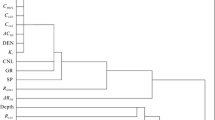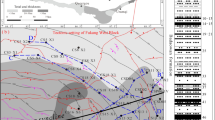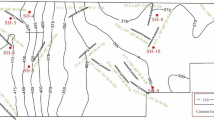Abstract
Accurate prediction of the spatial distribution of permeability of coal reservoirs using scare data from wells for coalbed methane exploration and development can lay a foundation for evaluating its gas production potential. By taking the #3 coal seam in the southern Shizhuang area in Qinshui Basin (Shanxi Province, China) as a research area, 23 key interpolation points that control the permeability of the coal seam were identified using a method that combines staged stripping of the structural stress field and structural curvature superposition. Permeability at the key interpolation points was calculated by combining the geological strength index (GSI) and regression of logging curve. The prediction method for spatial distribution of permeability (i.e., the combination of staged stripping of the structural stress field, determination of key interpolation points, and permeability prediction at key interpolation points) was developed. The differences in the spatial distribution of permeability using a key point and different methods (i.e., kriging interpolation method, intersection method of prospecting network at an equal interval, and random point selection for the same number of wells) were compared with that of 90 wells in the study area. The results indicate that the key control points for permeability of the coal seam can be identified by staged stripping of the structural stress field and structural curvature superposition: The permeability at the key interpolation points can be predicted by GSI. In addition, the key interpolation points can predict the high-value, sub-high-value, sub-low-value, and low-value zones of permeability of the coal seam in the study area using the same data points. The spatial distribution of permeability predicted by the key interpolation points was more accurate than that predicted by the intersection method of the prospecting network at an equal space and random point selection method, and it is closer to the predicted results using four sets of data. This research provides a method and reference for predicting changes in the permeability of a coal seam under limited drilling data.







Similar content being viewed by others
References
Chen, S. D., Tang, D. Z., Tao, S., Zhao, J. L., Li, Y., & Liu, W. Q. (2016). Discussion about “critical depth” of deep coalbed methane in Zhengzhuang area, Qinshui Basin. Journal of China Coal Society, 41(12), 3069–3075.
Connell, L. D., Mazumder, S., Sander, R., Camilleri, M., Pan, Z. J., & Heryanto, D. (2016). Laboratory characterisation of coal matrix shrinkage, cleat compressibility and the geomechanical properties determining reservoir permeability. Fuel, 169, 499–512.
Fu, X. H., Qin, Y., & Jiang, B. (2003). Physical and numerical simulation of permeability of coal reservoir in central and southern part of the Qinshui Basin, Shanxi. Scientia Geologica Sinica, 2, 221–229.
Fu, X. H., Qin, Y., Wang, G. G., & Rudolph, V. (2009). Evaluation of coal structure and permeability with the aid of geophysical logging technology. Fuel, 88, 2278–2285.
Guo, H. Y., Bai, Y., Lin, H. X., Li, G. S., & Su, X. B. (2014). Experimental study on permeability characteristics in complete evolution process of coal structure and its significance. Journal of China Coal Society, 39(11), 2263–2268.
Hoek, E., & Brown, E. T. (1997). Practical estimates of rock mass strength. International Journal of Rock Mechanics and Mining Sciences, 34(8), 1165–1186.
Li, J. Q., Liu, D. M., Yao, Y. B., Cai, Y. D., & Qiu, Y. K. (2011). Evaluation of the reservoir permeability of anthracite coals by geophysical logging data. International Journal of Coal Geology, 87, 121–127.
Li, Y. P., Shen, J., Yang, C. L., & Zhang, J. B. (2017). Characteristics and its geological implication of ground stress in Zhengzhuang Block of Qinshui Basin. Coal Science and Technology, 45(10), 176–181+100.
Li, J. H., Su, X. B., Lin, X. Y., & Guo, H. Y. (2008). Development characteristics of rock joins in coal-bed gas exploitation area in Qinshui Basin. Mining Safety & Environmental Protection, 35(5), 37–39. (in Chinese).
Liu, D. M., Zhou, S. D., Cai, Y. D., & Yao, Y. B. (2017). Study on effect of geo-stress on coal permeability and its controlling mechanism. Coal Science and Technology, 45(6), 1–8+25.
Ma, R. H., & Wang, A. Z. (2006). Mapping palaeostructural evolution with tectonic reconstruction theory. Natural Gas Industry, 26(1), 34–36. (in Chinese).
Meng, Z. P., & Hou, Q. L. (2013). Coupling model of stress-dependent permeability in high-rank coal reservoir and its control mechanism. Chinese Journal of Geophysics, 56(2), 667–675.
Ni, X. M., Yang, Y. H., Wang, Y. B., & Ye, J. P. (2016). Study on gas production and water production characteristics of CBM vertical wells under multi period tectonic movement of un-development fault in central south Qinshui Basin. Journal of China Coal Society, 41(4), 921–930.
Ni, X. M., Zhao, Y. C., Cao, Y. X., & Gao, L. (2017). Distribution characteristics of coal reservoir permeability under the action of tectonic movement in western Fukang mining area. Coal Geology & Exploration, 45(6), 40–45. (in Chinese).
Pan, Z., & Connell, L. D. (2012). Modelling permeability for coal reservoirs: A review of analytical models and testing data. International Journal of Coal Geology, 92(1), 1–44.
Qin, Y., Jiang, B., Wang, J. X., Wu, C. F., Fu, X. H., Wei, C. T., et al. (2008). Coupling control of tectonic dynamical conditions to coalbed methane reservoir formation in the Qinshui Basin, Shanxi, China. Acta Geologica Sinica, 82(10), 1355–1362. (in Chinese).
Qin, Y., Moore, T. A., Shen, J., Yang, Z. B., Shen, Y. L., & Wang, G. (2018). Resources and geology of coalbed methane in China: A review. International Geology Review, 60(5–6), 777–812.
Shen, J., Qin, Y., Fu, X. H., Wang, B. W., & Yang, S. (2010). Application of structural curvature of coalbed floor on CBM development in the Zaoyuan block of the southern Qinshui. Mining Science and Technology, 6, 886–890.
Shen, J., Qin, Y., & Li, Y. P. (2018). In situ stress field in the FZ Block of Qinshui Basin, China: Implications for the permeability and coalbed methane production. Journal of Petroleum Science and Engineering, 170, 744–754.
Teng, J., Yao, Y. B., Liu, D. M., & Cai, Y. D. (2015). Evaluation of coal texture distributions in the southern Qinshui basin, North China: Investigation by a multiple geophysical logging method. International Journal of Coal Geology, 140, 9–22.
Wang, Y. J., Liu, D. M., Cai, Y. D., Yang, Y. B., & Zhou, Y. F. (2018). Evaluation of structured coal evolution and distribution by geophysical logging methods in the Gujiao Block, northwest Qinshui basin, China. Journal of Natural Gas Science and Engineering, 51, 210–222.
Wood, D. M. (2020). Predicting porosity, permeability and water saturation applying an optimized nearest-neighbour, machine-learning and data-mining network of well-log data. Journal of Petroleum Science and Engineering, 184, 106587.
Xing, Y. A., Zhang, S. H., Tang, S. H., Guo, Y. Y., Yu, T. C., & Zhu, W. P. (2020). Study on in situ stress characteristics of coalbed methane reservoir in Laochang Mining Area, eastern Yunnan. Coal Science and Technology, 48(06), 199–206.
Zhang, J. B., Qin, Y., Wang, H. Y., & Chen, J. G. (2003). Structural prediction of high permeability coal reservoir distribution. Geological Journal of China Universities, 9(3), 359–364.
Zhao, Z. Q., Tao, S., & Tang, D. Z. (2020). A mathematical method to identify and forecast coal texture of multiple and thin coal seams by using logging data in the Panguan syncline, western Guizhou, China. Journal of Petroleum Science and Engineering, 185, 106616.
Zuber, M. D., Sparks, D. P., & Lee, W. J. (1990). Design and interpretation of injection/falloff tests for coalbed methane wells. SPE Annual Technical Conference and Exhibition (pp. 23–26). New Orleans: Louisiana.
Acknowledgments
This study was supported by National Major Science and Technology Projects of China (2017ZX05064-003-001), the National Natural Science Foundation of China (41872174 and 42072189), and the Central Plains Economic Zone of Coal Seam Gas (Ye Yan) Henan Collaborative Innovation Centre.
Author information
Authors and Affiliations
Corresponding author
Rights and permissions
About this article
Cite this article
Ni, X., Yang, C., Wang, Y. et al. Prediction of Spatial Distribution of Coal Seam Permeability Based on Key Interpolation Points: A Case Study from the Southern Shizhuang Area of the Qinshui Basin. Nat Resour Res 30, 1547–1559 (2021). https://doi.org/10.1007/s11053-020-09805-1
Received:
Accepted:
Published:
Issue Date:
DOI: https://doi.org/10.1007/s11053-020-09805-1




